Belenus is an ancient Celtic healing god. The cult of Belenus stretched from the Italian Peninsula to the British Isles, with a main sanctuary located at Aquileia, on the Adriatic coast. Through interpretatio romana, Belenus was often identified with Apollo, although his cult seems to have preserved a certain degree of autonomy during the Roman period.
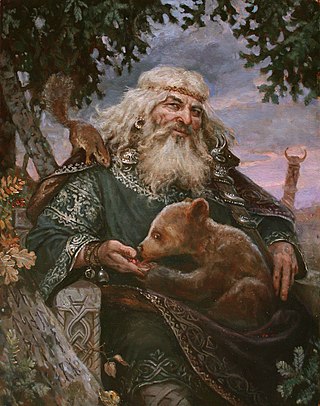
Veles, also known as Volos, is a major god of earth, waters, livestock, and the underworld in Slavic paganism. His mythology and powers are similar, though not identical, to those of Odin, Loki and Hermes.

Slavic mythology or Slavic paganism is the religious beliefs, myths, and ritual practices of the Slavs before Christianisation, which occurred at various stages between the 8th and the 13th century. The South Slavs, who likely settled in the Balkan Peninsula during the 6th–7th centuries AD, bordering with the Byzantine Empire to the south, came under the sphere of influence of Eastern Christianity, beginning with the creation of writing systems for Slavic languages in 855 by the brothers Saints Cyril and Methodius and the adoption of Christianity in Bulgaria in 864 and 863 in Great Moravia. The East Slavs followed with the official adoption in 988 by Vladimir the Great of Kievan Rus'.

Dazhbog, alternatively Daždźboh, Dazhboh, Dažbog, Dazhdbog, Dajbog, Daybog, Dabog, Dazibogu, or Dadźbóg, was one of the major gods of Slavic mythology, most likely a solar deity and possibly a cultural hero. He is one of several authentic Slavic gods, mentioned by a number of medieval manuscripts, and one of the few Slavic gods for which evidence of worship can be found in all Slavic tribes.

Jarylo, alternatively Yaryla, Iarilo, Juraj, Jurij, or Gerovit, is alleged East and South Slavic god of vegetation, fertility and springtime.

Zorya is a figure in Slavic folklore, a feminine personification of dawn, possibly goddess. Depending on tradition, she may appear as a singular entity, often called "The Red Maiden", or two or three sisters at once. Although Zorya is etymologically unrelated to the Proto-Indo-European goddess of the dawn *H₂éwsōs, she shares most of her characteristics. She is often depicted as the sister of the Sun, the Moon, and Zvezda, the Morning Star with which she is sometimes identified. She lives in the Palace of the Sun, opens the gate for him in the morning so that he can set off on a journey through the sky, guards his white horses, she is also described as a virgin. In the Eastern Slavic tradition of zagovory she represents the supreme power that a practitioner appeals to.

Mokosh is a Slavic goddess mentioned in the Primary Chronicle, protector of women's work and women's destiny. She watches over spinning and weaving, shearing of sheep, and protects women in childbirth. Mokosh is the Mother Goddess.
Perkūnas was the common Baltic god of thunder, and the second most important deity in the Baltic pantheon after Dievas. In both Lithuanian and Latvian mythology, he is documented as the god of sky, thunder, lightning, storms, rain, fire, war, law, order, fertility, mountains, and oak trees.
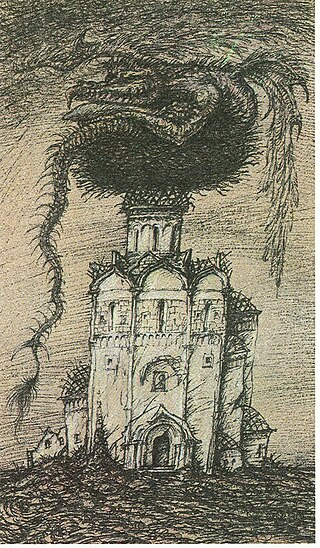
A Slavic dragon is any dragon in Slavic mythology, including the Russian zmei, Ukrainian zmiy, and its counterparts in other Slavic cultures: the Bulgarian zmey, the Slovak drak and šarkan, Czech drak, Polish żmij, the Serbo-Croatian zmaj, the Macedonian zmej (змеј) and the Slovene zmaj. The Romanian zmeu could also be deemed a "Slavic" dragon, but a non-cognate etymology has been proposed.

Radegast or Radogost is, according to medieval chroniclers, the god of the Polabian Slavs, whose temple was located in Rethra. In modern scientific literature, however, the dominant view is that Radegast is a local nickname or a local alternative name of the solar god Svarozhits, who, according to earlier sources, was the chief god of Rethra. Some researchers also believe that the name of the town, where Svarozhits was the main deity, was mistakenly taken for a theonym. A popular local legend in the Czech Republic is related to Radegast.
A krsnik or kresnik is a type of vampire hunter, a shaman whose spirit wanders from the body in the form of an animal. The krsnik turns into an animal at night to fight off the kudlak, his evil vampire antithesis, with the krsnik appearing as a white animal and the kudlak as a black one. The krsnik's soul leaves the body, either voluntarily or due to a higher power, to fight evil agents and ensure good harvest, health, and happiness.
*Perkʷūnos is the reconstructed name of the weather god in Proto-Indo-European mythology. The deity was connected with fructifying rains, and his name was probably invoked in times of drought. In a widespread Indo-European myth, the thunder-deity fights a multi-headed water-serpent during an epic battle in order to release torrents of water that had previously been pent up. The name of his weapon, *ml̥dʰnis, which denoted both "lightning" and "hammer", can be reconstructed from the attested traditions.
Rethra was, in the 10th to the 12th centuries, the main town and political center of the Slavic Redarians, one of the four major Lutician tribes, located most likely in present-day Mecklenburg. It was also a major worship center, devoted to the cult of the Slavic deity Radegast-Swarożyc.

In Slavic mythology, Perun is the highest god of the pantheon and the god of sky, thunder, lightning, storms, rain, law, war, fertility and oak trees. His other attributes were fire, mountains, wind, iris, eagle, firmament, horses and carts, and weapons. The supreme god in the Kievan Rus' during the 9th-10th centuries, Perun was first associated with weapons made of stone and later with those of metal.

Rožnik is a hill in the Rožnik District and Šiška District northwest of the Ljubljana city center. Together with Tivoli City Park, it forms Tivoli–Rožnik Hill–Šiška Hill Landscape Park. Extending from Tivoli Park, it is a popular hiking, running, and excursion destination for residents of Ljubljana.
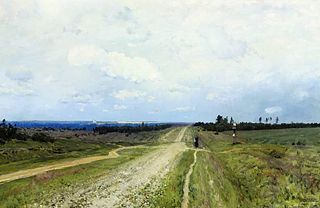
Nav is a phrase used to denote the souls of the dead in Slavic mythology. The singular form is also used as a name for an underworld, over which Veles exercises custody—it is often interpreted as another name for the underground variant of the Vyraj.
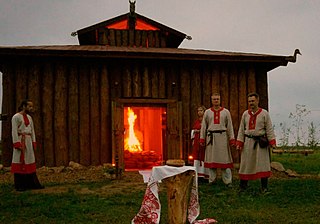
Svarozhits, Svarozhich is a Slavic god of fire, son of Svarog. One of the few Pan-Slavic gods. He is most likely identical with Radegast, less often identified with Dazhbog.

Studia mythologica Slavica is a Slovene academic journal dedicated to ethnology, history, archaeology, linguistics, religious studies, literary history and philosophy in the context of Slavic mythology. Published since 1998 by the Institute of Slovenian Ethnology and the University of Udine. The journal is an annual published in print and online. Articles are published in all Slavic languages, in English, German and Italian. The main goal of the journal is to present comparative research that presents Slavic culture in the broader context of European and non-European cultures. The journal also encourages the study of contemporary phenomena of spiritual, social and material culture and their transformations.
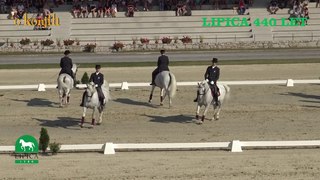
Horses in Slovenia are represented above all by the traditional Lipizzan breed, inherited from Austria-Hungary; like Austria, Slovenia claims the Lipizzan as its national symbol. Horses have long been present on Slovenian territory; draft horses suffered a sharp decline in the 20th century, with only the native breeds of Slovenian Cold-blood and Posavina surviving. Slovenian breeders also have sport horses, such as the Slovenian Saddlebred and the Ljutomer Trotter. Slovenians distinguish their native horse breeds from traditional breeds.














